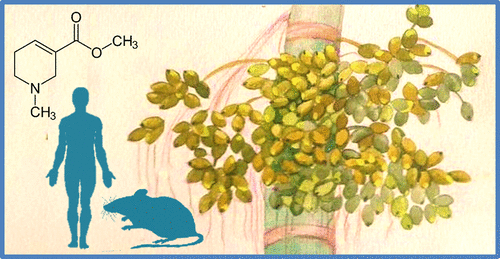当前位置:
X-MOL 学术
›
ACS Chem. Neurosci.
›
论文详情
Our official English website, www.x-mol.net, welcomes your
feedback! (Note: you will need to create a separate account there.)
DARK Classics in Chemical Neuroscience: Arecoline.
ACS Chemical Neuroscience ( IF 4.1 ) Pub Date : 2019-02-21 , DOI: 10.1021/acschemneuro.8b00711 Andrey D Volgin,Alim Bashirzade,Tamara G Amstislavskaya,Oleg A Yakovlev,Konstantin A Demin,Ying-Jui Ho,Dongmei Wang,Vadim A Shevyrin,Dongni Yan,Zhichong Tang,Jingtao Wang,Mengyao Wang,Erik T Alpyshov,Nazar Serikuly,Edina A Wappler-Guzzetta,Anton M Lakstygal,Allan V Kalueff
ACS Chemical Neuroscience ( IF 4.1 ) Pub Date : 2019-02-21 , DOI: 10.1021/acschemneuro.8b00711 Andrey D Volgin,Alim Bashirzade,Tamara G Amstislavskaya,Oleg A Yakovlev,Konstantin A Demin,Ying-Jui Ho,Dongmei Wang,Vadim A Shevyrin,Dongni Yan,Zhichong Tang,Jingtao Wang,Mengyao Wang,Erik T Alpyshov,Nazar Serikuly,Edina A Wappler-Guzzetta,Anton M Lakstygal,Allan V Kalueff

|
Arecoline is a naturally occurring psychoactive alkaloid from areca (betel) nuts of the areca palm ( Areca catechu) endemic to South and Southeast Asia. A partial agonist of nicotinic and muscarinic acetylcholine receptors, arecoline evokes multiple effects on the central nervous system (CNS), including stimulation, alertness, elation, and anxiolysis. Like nicotine, arecoline also evokes addiction and withdrawal symptoms (upon discontinuation). The abuse of areca nuts is widespread, with over 600 million users globally. The importance of arecoline is further supported by its being the world's fourth most commonly used human psychoactive substance (after alcohol, nicotine, and caffeine). Here, we discuss neuropharmacology, pharmacokinetics, and metabolism of arecoline, as well as social and historical aspects of its use and abuse. Paralleling clinical findings, we also evaluate its effects in animal models and outline future clinical and preclinical CNS research in this field.
中文翻译:

化学神经科学领域的经典著作:槟榔碱。
槟榔碱是一种天然存在的精神活性生物碱,来自南亚和东南亚特有的槟榔(槟榔)的槟榔。槟榔碱是烟碱和毒蕈碱乙酰胆碱受体的部分激动剂,对中枢神经系统(CNS)产生多种作用,包括刺激,机敏,兴高采烈和抗焦虑作用。像尼古丁一样,槟榔碱也会引起成瘾和戒断症状(停药后)。槟榔的滥用非常普遍,全球有超过6亿用户。槟榔碱是世界上第四大最常用的人类精神活性物质(仅次于酒精,尼古丁和咖啡因),进一步证明了槟榔碱的重要性。在这里,我们讨论槟榔碱的神经药理学,药代动力学和新陈代谢,以及其使用和滥用的社会和历史方面。
更新日期:2019-01-21
中文翻译:

化学神经科学领域的经典著作:槟榔碱。
槟榔碱是一种天然存在的精神活性生物碱,来自南亚和东南亚特有的槟榔(槟榔)的槟榔。槟榔碱是烟碱和毒蕈碱乙酰胆碱受体的部分激动剂,对中枢神经系统(CNS)产生多种作用,包括刺激,机敏,兴高采烈和抗焦虑作用。像尼古丁一样,槟榔碱也会引起成瘾和戒断症状(停药后)。槟榔的滥用非常普遍,全球有超过6亿用户。槟榔碱是世界上第四大最常用的人类精神活性物质(仅次于酒精,尼古丁和咖啡因),进一步证明了槟榔碱的重要性。在这里,我们讨论槟榔碱的神经药理学,药代动力学和新陈代谢,以及其使用和滥用的社会和历史方面。































 京公网安备 11010802027423号
京公网安备 11010802027423号